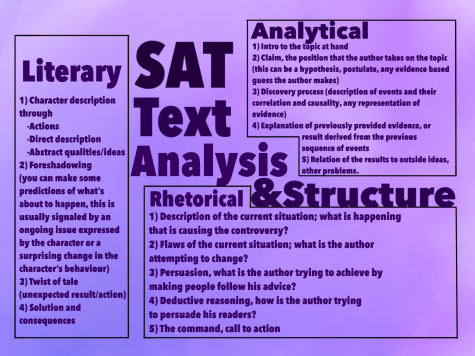SAT Reading section techniques, tactics
Strategies on deeper, more efficient text analysis
Approximately a third of the three-hour SAT is dedicated to the reading section, which assesses students’ ability to make evidence-based inferences and conclusions.
When breaking down a large body of text in a limited amount of time, students are expected to rely on their critical thinking. This ability can be developed and enhanced through simple steps when it comes to reading and analyzing.
According to the Pareto Principle, only 20 percent of the text is crucial in understanding the concept the author is trying to convey. 80 percent of the information has to be simplified and 20 percent of the most important information has to be elevated — meticulously analyzed and used for deeper understanding, according to Investopedia.

Authors use techniques such as sentence structure, tone of voice, passage structure and reasoning in ways specific to each genre. The five passages of the SAT include: one literary passage, three analytical passages and one rhetorical passage.
First, start by reading and analyzing the title, author and any information given about the passage. Titles can reveal the author’s stance, the two concepts being evaluated and the genre of the text. Compare the time period of the author to our time period to try to understand the environment of the author.
The easiest way to organize ideas is to put them in comparison, according to Chris Steyaert and Maddy Janssens’ strategies in organization in literature. Simply put, look for two things that appear to be the subject of the story and examine their relationship.
As you read, take notes on each of the binary subjects. Pay close attention to sentences in the form of “If… then… ” because they most often contain key ideas of the text. This advice is especially useful for the literary and the rhetorical section.
While reading the literary passage, look for what the character wants: what motivates them and what desire drives their actions?
Authors often implement an ironic tone, which highlights a gap between the real and the abstract. This gap often conveys a deeper meaning, connecting the events in the passage to a universal lesson. Another popular tone is the poetic tone, and although it includes a lot of imagery, it is important to separate symbolic metaphors from unnecessary illustrations.
Often, questions in the literary section apply to the symbolic, universal meaning behind the events and characters in the passage. So, when deciding between two answers, choosing the more general, universally applicable answer will increase your chances of being correct. This does not apply to the analytical or rhetorical passages.
For the rhetorical section, you will be asked to analyze two opposing opinions on a controversial idea in history. Most common themes for the SAT are women’s rights, African American rights and immigrants’ rights, so it would be helpful to research those topics in advance. Practice reading and analyzing speeches of leaders from those movements.
Pay close attention to the way the author describes his reasoning. Most of the SAT passages are taken from time periods where people did not rely on science and data as much as we do today, so authors at that time relied on deductive reasoning.
The analytical passages always follow a straightforward structure. The first paragraph usually serves as an introduction, but by the end of the first paragraph or the beginning of the second paragraph, the author should have now fully formed their claim. Then, the author will enter the process of justifying the claim by deriving and explaining data. The passage will end with a paragraph expanding on the subject with the mention of related topics.
Knowing how to accurately and efficiently analyze text will not only lead to good grades but will also help you save time on reading homework assignments, as a great percentage of information can always be omitted and interpreted.







